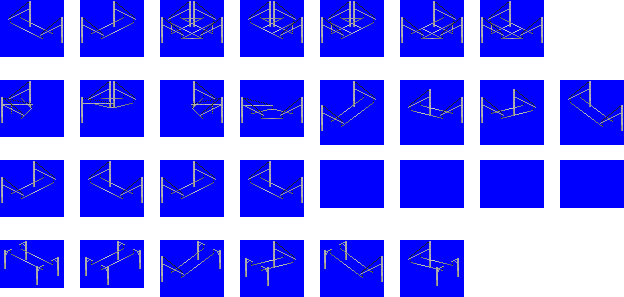Action3/Roadtypes
Introduction
Action 3 assigns graphics sets (referenced to by (chains of) action 2(s) to feature IDs.
![]() 1.10
1.10 ![]() Roadtypes are available only in OpenTTD > 1.10
Roadtypes are available only in OpenTTD > 1.10
Format
The format of the data is feature-dependent. For roadtypes it looks like
<Sprite-number> * <Length> 03 10 <n-id> <ids...> <num-cid> <cargo-type> <set-ID>... <default set-ID>
| Element | Size | Description |
|---|---|---|
| <Sprite-number> | dec | A sequential sprite number |
| <length> | dec | The total number of bytes used in this action |
| 03 | B | Defines action 03 |
| 12 | B | The feature byte for roadtypes |
| <n-id> | B | Number of IDs this action 3 associates graphics with |
| <ids...> | B/B* | IDs of the current feature this action 3 associates graphics with. There must be as many IDs as <n-id> specifies |
| <num-cid> | B | Number of different "cargo" types to support |
| <cargo-type> | B | "Cargo" type for which to use the following set-ID |
| <set-ID> | W | Set-ID (from action 2 or from a varaction2 chain) to use for this cargo type |
| <default set-ID> | W | Default set-ID to use if none of the above matches |
Description
Sprite-number
This is just the number you are at.
Length
Count the number of bytes in this action.
n-id
How many items of the current feature this action 3 defines new graphics for. If this is more than one, all items listed will get the same graphics. If this value has bit 7 set (i.e. 80 added), it is a wagon override. See Action 3 - Livery Override for more info on this feature.
You can make a definition with n-id equal to zero (and thus no ids that follow). This creates a generic feature-specific definition not associated with any particular item. At the moment, this is used for generic callbacks, but might be extended to other functions eventually.
ids
Feature IDs to use this action 3 for. All IDs are counted from the first of their class, i.e. the first road vehicle has 00, as does the first plane, the first ship, and the first train vehicle.
num-cid
Number of "cargo" type definitions that follow.
cargo-type
Roadtypes re-uses in its Action3 the 'cargo'-type definition in order to assign the type of graphics defined by the associated set-ID:
| 'Cargo' Type | Sprite Type | #Sprites | Useage |
|---|---|---|---|
| 00 | Icons and cursors | 12 | 4 road directions, autoroad, depot, tunnel and convert road. First all icons, then all cursors. |
| 01 | Track overlays[1] | 19 | 11 roadbit combinations, 4 slopes, and 4 dead ends. These sprites are optional for roadtypes. |
| 02 | Underlay[1] | 19 | 11 roadbit combinations, 4 slopes, and 4 dead ends. These sprites are required. |
| 04 | Catenary front | 29 | 11 roadbit combinations, 4 slopes, 4 dead ends, 4 tunnels, 2 bridge middle, 4 bridge ramps |
| 05 | Catenary back | 29 | 11 roadbit combinations, 4 slopes, 4 dead ends, 4 tunnels (unused), 2 bridge middle, 4 bridge ramps |
| 06 | Bridge surfaces[1] | 6 | 2 bridge middle, 4 bridge ramps |
| 08 | Depots | 6 | Follows the original layout for depot sprites. If not present, the default depot sprites (depending on catenary flag) plus track overlay are drawn. If present, the depot sprites are expected to include track overlay graphics. |
| 0A? | Road stops | 4 | Overlays for drive-in road stops |
GUI sprites (00)
Road underlay (02)
Catenary front (04)
Catenary back (05)
Depot sprites (08)
| Sprite Number | Usage |
|---|---|
| 0 | NE wall for SE-entry depot. |
| 1 | Depot building for SE-entry depot. |
| 2 | NW wall for SW-entry depot. |
| 3 | Depot building for SW-entry depot. |
| 4 | Depot building for NE-entry depot. |
| 5 | Depot building for NW-entry depot. |
Bridge surfaces (06)
Road stops (0A?)
default set-ID
The default set-ID would be used for roadtype callbacks. However, since there are currently no callbacks for roadtypes it should always result in a callback-failure.



